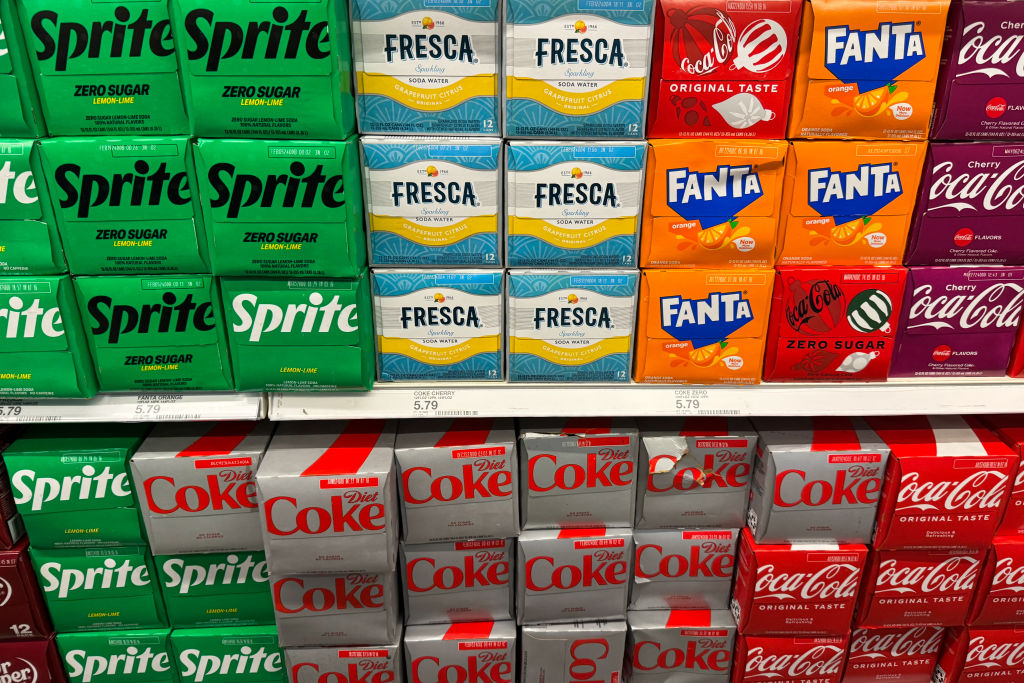Steel Tariffs Double: What Trump’s 50% Hike Means for Soda, Housing Prices
The president enacted 50% tariffs on aluminum and steel imports. Here's how it could impact you.


Trump’s latest sweeping tariffs on certain metals may broadly impact everyday goods, from certain foods in the grocery aisle to the price of your child’s bike.
On June 4, 2025, President Donald Trump signed an executive proclamation doubling tariffs on steel and aluminum imports to 50%, effective immediately. This sharp escalation is designed to further protect U.S. metal producers and comes amid ongoing global trade tensions.
The new 50% tariff applies to nearly all trading partners, with the exception of the United Kingdom, which has secured a temporary exemption through ongoing negotiations.
From just $107.88 $24.99 for Kiplinger Personal Finance
Become a smarter, better informed investor. Subscribe from just $107.88 $24.99, plus get up to 4 Special Issues

Sign up for Kiplinger’s Free Newsletters
Profit and prosper with the best of expert advice on investing, taxes, retirement, personal finance and more - straight to your e-mail.
Profit and prosper with the best of expert advice - straight to your e-mail.
This latest move comes just months after, on February 10, Trump signed proclamations raising steel and aluminum tariffs to 25% and eliminating most country exemptions.
Those tariffs, which took effect March 12, 2025, had already impacted major suppliers, including Canada and Mexico. The June 4 action now doubles those rates, intensifying the effect across the U.S. economy.
Here’s what the latest tariffs on key metals mean for you.
Trump's steel tariffs
The initial 25% measures are an expansion of Trump’s 2018 Section 232 duties, which had set steel tariffs at 25% and taxes on aluminum imports at 10%. The Trump administration previously said the tax was in place to counter trade practices that “undermine national security.”
- Such tariffs, however, can have broad impacts across different industries.
- For homebuyers in the U.S., tariffs on essential building materials usually translate to higher home prices.
- Meanwhile, homebuilders worry the tariffs will impact construction costs and hinder their ability to deliver new projects.
Experts say you can expect higher prices from canned foods, beer, and soda in the grocery aisle, as many rely on imports from Canada and Mexico. Even domestic car prices may be slightly impacted.
With the tariff rate now at 50%, some industry analysts warn that the price impacts will be even more pronounced. The cost of steel and aluminum-intensive goods — from vehicles to beverage cans — is expected to rise further as manufacturers pass on the higher input costs to consumers.
Canada and Mexico push back
In response to President Trump’s June 4 announcement doubling steel and aluminum tariffs, Canadian officials have issued objections.
Canada’s ambassador to the U.S., Kirsten Hillman, called the move “unideal,” warning that it will drive up costs for American consumers and disrupt supply chains.
Catherine Cobden, president of the Canadian Steel Producers Association, described the tariff hike as “another painful blow,” urging Ottawa to “restore mirror duties on U.S. steel” and take further action to protect the Canadian industry.
- According to the Canadian Steel Association, about $20 billion in steel is traded between Canada and the U.S. each year.
- Additionally, 40% of Canada’s steel imports come from the United States.
Mexico also responded to the June 4 steel tariff hike by announcing it will formally seek an exemption.
Economy Minister Marcelo Ebrard said, “It’s not equitable and it’s not sustainable. We will present our case on Friday to have Mexico excluded from this measure.”
He also reportedly noted that Mexico has a contingency plan if the tariffs remain, cautioning that the new rules would negatively affect the country’s automotive, construction, and electronics sectors.
- Ebrard has previously said the U.S. had a $6.9 billion surplus with Mexico on steel and aluminum trade in 2024.
- The government argues that retaliatory tariffs on United States imports of those metals would have a harsher economic impact.
What about retaliation? Following the March 12 implementation of the 25% tariffs, Canada responded with 25% tariffs on more than $20 billion worth of U.S. goods, and the European Union imposed reciprocal tariffs on $28 billion of U.S. goods imported to Europe.
With the June 4 escalation to 50%, Canada and the EU are reportedly considering expanding their lists of retaliatory tariffs. U.S. trading partners are warning of further disruptions if the higher tariffs remain in place.
Tariffs raise prices on canned goods, vehicles, and housing

Trump’s tariffs on steel and aluminum will impact several industries. Some prices will be visible on your grocery list. And with the tariff now at 50%, these price increases will likely accelerate.
- Canned goods and beverages
Nearly 70% of tin plate steel used to make cans for fruits, vegetables, essential foods, and pet food is imported to the U.S., according to the Can Manufacturers Institute (CMI).
Many industries use aluminum and steel to manufacture their products, which can include beverages and sodas.
Coca-Cola CEO James Quincey said the company imports aluminum for its cans from Canada. In response to tariff hikes, the company may increase production of its beverage in plastic bottles.
It may also source aluminum domestically, which would likewise increase consumer prices.
- Newly built homes or renovations
Aluminum and steel are used as raw materials in home construction, which may lead to higher home prices as builders pass on tariff costs to consumers.
Homebuilders are also worried about supply-chain disruptions, which may impact their ability to deliver new projects.
- Automobiles and car parts
Canada’s steel and aluminum imports to the United States benefit the automotive, aerospace, and construction industries. Canada, Brazil, and Mexico were the largest suppliers of steel to the U.S. in January, with Canada firmly in the lead.
How can this hit domestic companies? Ford sources 90% of their steel from local manufacturers, and 10% from Canada.
However, Ford CEO Jim Farley reportedly said the company still has suppliers with international sources for aluminum and steel, so tariffs may impact prices.
If you want a European car model, you may also expect higher prices. The European Union announced it would respond with reciprocal tariffs if it comes to it.
Bottom line on aluminum and steel tariffs
Tariffs on imported goods from other countries and allies are taxes paid by domestic companies. These companies, like Coca-Cola, then pass on some of that additional cost to consumers like you to make a profit.
With the tariff now doubled to 50% as of June 4, the economic impact is expected to deepen.
U.S. steel and aluminum producers may benefit, but manufacturers and consumers will likely face higher costs and greater uncertainty.
Related Content
- Tariffs: What They Are and How They Impact Your Wallet
- Food, Gas, Prices to Spike it Trump Levies Tariffs on Canada and Mexico
- Trump’s Tariffs Could Dramatically Spike Clothes, Toy Prices in 2025
Profit and prosper with the best of Kiplinger's advice on investing, taxes, retirement, personal finance and much more. Delivered daily. Enter your email in the box and click Sign Me Up.

Gabriella Cruz-Martínez is a finance journalist with 8 years of experience covering consumer debt, economic policy, and tax.
Gabriella’s work has also appeared in Yahoo Finance, Money Magazine, The Hyde Park Herald, and the Journal Gazette & Times-Courier.
As a reporter and journalist, she enjoys writing stories that empower people from diverse backgrounds about their finances, no matter their stage in life.
-
 IRS Says You Made a Tax Return Mistake? A New Law Could Help You Fight Back
IRS Says You Made a Tax Return Mistake? A New Law Could Help You Fight BackTax Law Updated taxpayer protections change what the IRS must explain on error notices and how long you have to respond.
-
 What to expect from the global economy in 2026
What to expect from the global economy in 2026The Kiplinger Letter Economic growth across the globe will be highly uneven, with some major economies accelerating while others hit the brakes.
-
 What You Need to Do With Your 401(k) Before 2025 Is Over
What You Need to Do With Your 401(k) Before 2025 Is OverBefore 2025 ends, check your 401(k) contributions, investments, and catch-up eligibility to lock in this year’s tax savings and employer match.
-
 IRS Says You Made a Tax Return Mistake? A New Law Could Help You Fight Back
IRS Says You Made a Tax Return Mistake? A New Law Could Help You Fight BackTax Law Updated taxpayer protections change what the IRS must explain on error notices and how long you have to respond.
-
 Is a New $25,000 Health Care Tax Deduction Coming in 2026?
Is a New $25,000 Health Care Tax Deduction Coming in 2026?Tax Policy A proposal from GOP Sen. Josh Hawley adds to the chatter about health care affordability.
-
 Costco Sues Over Trump Tariffs: What Could That Mean for Prices in 2026?
Costco Sues Over Trump Tariffs: What Could That Mean for Prices in 2026?Tariffs The retailer is making headlines not just for its famous hot dog and gold bars but for suing the Trump administration over tariffs.
-
 Social Security Benefits Quiz : Do You Know the IRS Tax Rules?
Social Security Benefits Quiz : Do You Know the IRS Tax Rules?Quiz Social Security benefits often come with confusing IRS tax rules that can trip up financially savvy retirees and near-retirees.
-
 New 2026 Tax Change Could Mean More for Your IRA and 401(k) Savings
New 2026 Tax Change Could Mean More for Your IRA and 401(k) SavingsRetirement Savings Here's how the new IRS inflation adjustments will increase the contribution limits for your 401(k) and IRA in the new year.
-
 Capital Gains Tax Quiz: How Well Do You Really Know IRS Investment Tax Rules?
Capital Gains Tax Quiz: How Well Do You Really Know IRS Investment Tax Rules?Quiz Take our capital gains tax quiz to test your investment taxes knowledge. Learn about loss rules, holding periods, and tax incentives that could impact your savings.
-
 6 Tax Reasons to Convert Your IRA to a Roth (and When You Shouldn't)
6 Tax Reasons to Convert Your IRA to a Roth (and When You Shouldn't)Retirement Taxes Here’s how converting your traditional retirement account to a Roth IRA can boost your nest egg — but avoid these costly scenarios.
-
 Are New Trump $2,000 Stimulus Payments Coming in 2026? What to Know Now
Are New Trump $2,000 Stimulus Payments Coming in 2026? What to Know NowTax Policy A promise of $2,000 tariff dividend checks is raising questions and fueling confusion.